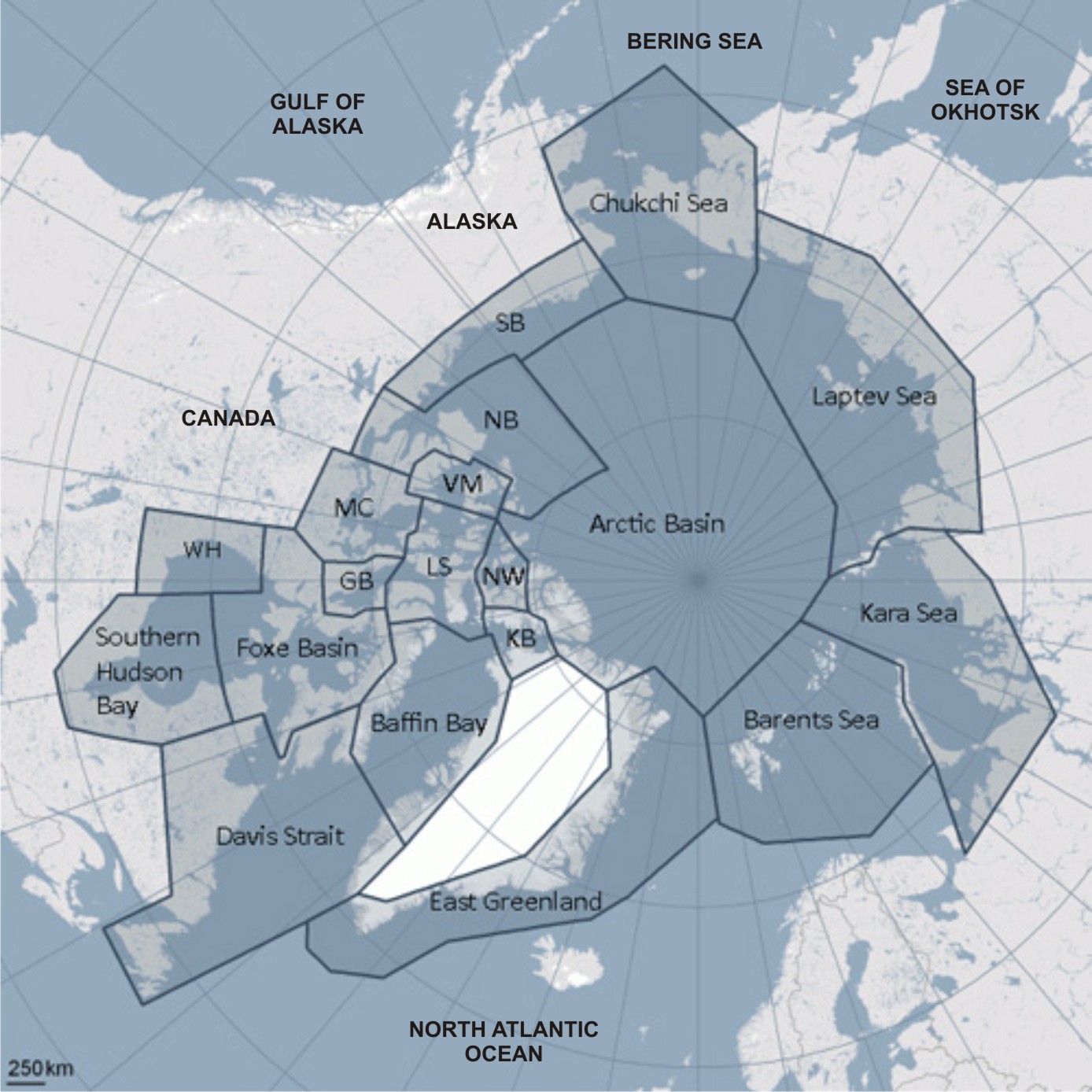Hello all,
Today's post will focus on another species that will be directly affected by climate change: the Polar Bear, or Ursus Maritimus
(Durner et al., 2009). The link between climate change and danger for polar bear survival was first discussed in 1993, by
Stirling and Derocher. They are still the most cited experts in the field and have both published multiple papers on the various aspects of this issue.
Figure 1: Polar Bear, to illustrate what we're talking about.
Figure 2: Their habitat
Polar bears' habitat is the sea ice near shore, throughout the circumpolar Arctic; the polar region around the North Pole
(Derocher et al., 2004). Their preference is for dynamic sea ice of which the ice plateaus constantly shift, giving access to gaps of open water called
Polynyas,
(Stirling, 1997). They vary in shape and size and are the product of several factors, including upwellings, current, wind or a combination of these
(Stirling, 1997). These polynyas are the polar bears' main hunting environment, where they catch their most important source of food: ringed seals. For the latter, polynyas are the main habitat, with a necessity for easy access to larger ice surfaces to give birth to and nurse their offspring
(Stirling and Derocher, 1993). In order for both these species to exist in a stable equilibrium, the existence of sea ice and polynyas is essential
(Stirling, 2002).
However, climate change impacts their future species survival due to vanishing sea ice. There are several climate models that predict the extent of future arctic sea ice, which is difficult to model and thus there are differences between the results of individual studies. The overall consensus however, appears to be that "overall, climate is warming, total ice cover is decreasing at a significant rate, and that large parts of the polar basin may be largely or completely ice-free in as little as 100 years"
(Derocher et al., 2004). Empirical evidence shows that between 1976 and 2006, sea ice declined with an annual average of 8.6%, and 2007 being the record year with the lowest extent of summer sea ice
(Serreze et al., 2007). These are all indications of change affecting polar bear habitat: earlier annual ice break up, and later freeze up (
(Derocher et al., 2004), shifting the seasonal activity for polar bears and seals.
For polar bears, late spring and early summer is the period most crucial to survival. It is the time they do on-ice feeding on seals, storing body fat for the on-land period of fasting. When ice patterns progress as indicated above, the hunting period becomes shorter while the fasting period becomes longer. Also, due to increased drifting, the distance between ice plateaus will become larger and thus moving within its habitat will become more energy-consuming
(Durner et al., 2009).
Derocher et al. estimated, based on averages from research in the Hudson Bay area, what this would do to the polar bear's ecology. Their results indicated that due to body mass loss, by 2100, most female polar bears would not have enough body fat to produce viable offspring, leading to extinction of the species
(Derocher et al., 2004).
This is likely going to be accelerated by the non-availability of seals, whose population will decline because of lack of space for safe offspring bearing
(Durner et al., 2009). This relationship between seal productivity and polar bear reproduction was already observed by
Stirling in 2002. It is a commonly observed relationship in population ecology, made more comprehensible by the Lotka Volterra Predator Prey Model, though
McLaren and Smith, 1985, warn the reader against its oversimplicity and lack of spacial parameters. Still, it is worthwhile in developing an understanding in the Polar Bear - Seal population dynamics and I'll do a brief discussion below in order to show you how all-encompassing an effect the sea ice decline will most likely have.
I am assuming some knowledge of the Lotka Volterra Model or a similar coupled differential equation model here. For an explanation, I recommend you refer to the following PAPER by Baigant, based at UCL.
For an interest in mathematical ecology and population dynamics in general, I recommend Pastor's book Mathematical Ecology of Populations and Ecosystems. (Do mind: it's on its first edition, so includes many small mistakes in the equations. The theory is very thoroughly explained.)
Figure 3: the Lotka Volterra Equation in its simplest form.
In which:
R= Polar Bear Population Density
a= Polar Bear Growth Rate
alpha= Probability of killing a seal
F= Seal Population Density
Beta = probability of killing x polar bear's efficiency of conversion into biomass
b = random death rate
As is illustrated by the equation and what the symbols represent, a decline in sea ice will impact the population dynamics in various ways.
The decline of seal habitat influences productivity, thus
F its population density, and
alpha and
beta, due to the altered polar bear's probability of killing seal.
The polar bear's mass, which as explained above will decline and lead to less offspring, impacts
a the polar bear growth rate.
This all will have a total effect on the two population densities, and thus shift the equilibrium, potentially away from a stable coexistence equilibrium.
Time will tell how both polar bears and seals will (cease to) exist with declining sea ice. I hope you enjoyed the post and it got you thinking on the 'snowball effect' of climate change: its impact on one species affects another.






















 WikiMiniAtlas
WikiMiniAtlas

